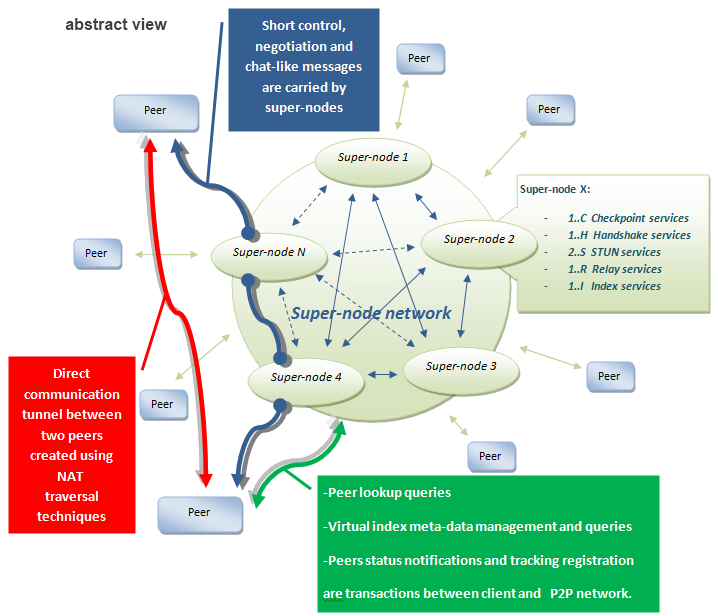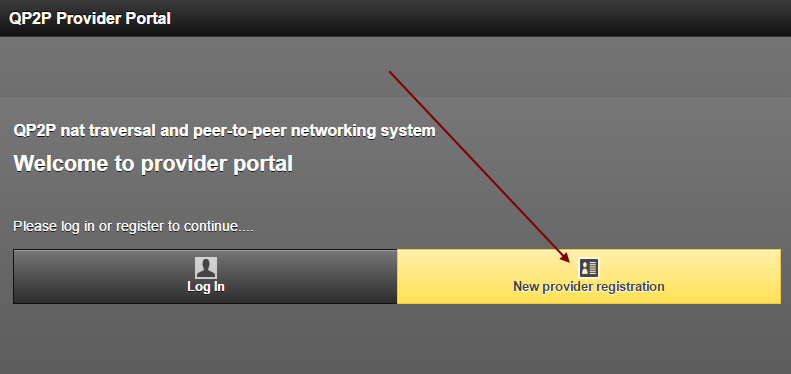

QuickP2P system is general purpose NAT traversal/Peer-to-peer networking API. Its peer-to-peer system of so-called "mixed" type because it uses super-nodes as key points of a network. This architecture is proven as most usable compared to other types of peer-to-peer network architectures. It is because it basically takes the best possible ways of implementation. There are similar solutions like this, like Skype and LogMe In. But neither of them comes in a package as quickP2P providing your API so you can bring those functionalities to your application.

Supernode network is unlimitedly scalable. The minimal quickP2P network has one supernode equipped with 1 checkpoint service, 1 handshake service, 2 STUN services, 1 Relay and 1 Index service. An unlimited number of new supernodes can be added to the network and they will all act as one. Information published by one peer connected to any supernode is available to all other supernodes. Instant message can always find it's way from one peer to any other peer.
Peers can do various lookups and negotiations on a network. When they decide to create the direct tunnel between them, some handshake service chosen by the system will help them create it. After creation tunnel connection is totally independent on the quickP2P network. For example, if the client loses connection to supernodes, this tunnel will continue to exists. It is because basically tunnel depends only on mappings in NAT tables of routers between two peers. These mappings are forced during handshake procedure. They will be available as long as two peers maintain connection sending any data through it.
Ahe architecture described in above picture is not so important to the client itself (API user). All he needs to do is to establish a connection with any super-node. From his point of view that super-node will be a single entity that does all requested operations for him.
QuickP2P provides additional entry points except for peers like services to provide index data to management/support systems you may have for your application.
QuickP2P is general purpose peer-to-peer NAT traversal system. It includes all things you need to build your own peer-to-peer application straight out of the box:
So package contains all you need to build your peer-to-peer application. In most cases, you just need to provide GUI, hook API, a bit of basic coding and you are ready to go on markets.
Except for easy use major advantages you will get using quickP2P:
* Most private and secure way of data transfer over the internet in the world today. Data transfer goes directly, there are no intermediate points. Encryption and secure key exchange which you can use at will be also available.
* Fast real-time communications between peers. Transfer speed is limited by peer host internet connections eliminating server factor in between. This imposes a low cost of system maintenance because you don’t need server power and bandwidth.
* Easy way of controlling custom remote electronic devices everywhere where internet is available. One practical example of use would be connecting device via SIM card modem. You can easily install SIM modem on your electronic board and use quickP2P on some embedded Linux installed in the device. This makes your device available for control and probing easily at an ultra-low cost.
* You don’t have to think about what type of networks clients have, it just connects in the best possible way
* You can build IPv6 like network with quickP2P
* Everything provided with API is available on all platforms where you use API
* QuickP2P does not require high user privileges to operate it uses sockets in a common way
* You can easily create VPN, RDP and other protocol tunnels to support other applications and services or to provide them additional security. Example of protocol additional securing would be P2P mail - mail that skips SMPT servers and goes from one peer to other directly.
* You can easily build applications that are similar to some of the world most popular applications most of us use every day...
* You can use it for multiplayer games without investment in game servers...
So there are plenty of reasons that may make you decide to use this system.
To use it, you need to download API for the right platform(s) you will work with and you need qp2p super-node. For super-node, you can choose to have your own, or for start, you can use our super-nodes so in that case you just need API. There are few types of subscription plans when using our super-nodes so you can choose one that suits your applications best. They can be based on time period or a number of created tunnels. Anyway, you will always get free evolution period or available free tunnel openings that are enough to develop and test your application.

You start by registering as quickP2P application provider. After that, you get access to provider portal where you can register your applications. For API client to work it will need to provide provider and application tokes so the system would let him in. Portal provides you all means to develop and monitor your applications. Every application you register will be enclosed in its scope.
API downloads, documentation, examples and engineering support are also things you will get on provider portal.
For start we recommend you go through examples we made available so you could easily get understanding of API concepts.